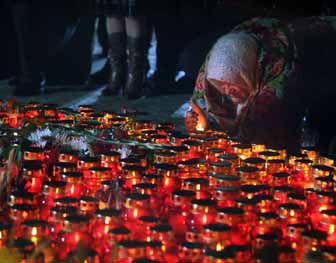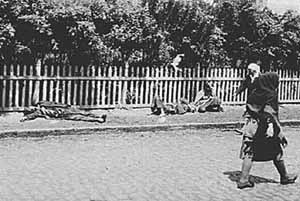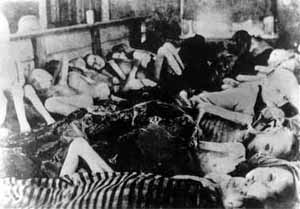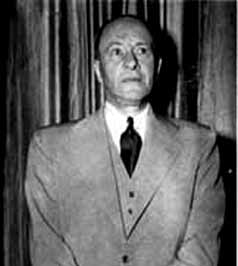 |
International Affairs
Lying to the Dead
Toby Westerman
Past is prologue, and it is difficult to present an idea as virtuous if it has resulted in the merciless deaths of millions of innocent victims. Such "virtue" makes people nervous, even if the mass murder happened almost 80 years ago. Slaughter has no statute of limitations, especially in the mind.

Lighting a candle to honor the memory of the 10 million killed in the Ukraine by Stalin |
The resurgent Communist movement has just that kind of past, which it is attempting to hide.
The people of the Ukraine are struggling to keep alive the memory of one of the most savage incidents the world has ever known: the 1932-33 famine. The National Memory Institute of Ukraine is the institution charged with that responsibility.
Sometimes known as the Great Famine, the Terror-Famine, or in Ukrainian, The Holodomor, as many as 10 million may have died during the years of the famine, which centered upon Ukraine. Although the toll in human life was astounding, the West knew little about the incident until Robert Conquest's Harvest of Sorrow was published in 1987.
The recently elected pro-Russian, pro-Communist government in Ukraine seems determined to re-cast the Terror-Famine as a tragedy that the Soviet Union attempted to stop.
The new Ukrainian government has put Valery Soldatenko, a proud Communist, in charge of the National Memory Institute. Soldantenko's personal belief is that the Soviet government under Josef Stalin did all it could to lessen the effects of the famine and sought to aid its victims.
Soldantenko falsely states that the famine was not initiated by Stalin, but was "the result of difficult circumstances," according to Radio Free Europe's Ukrainian Service.
The true story
The facts speak a far different story.
The background to the Terror-Famine was Stalin's determination to impose collective farming on an unruly peasantry. In the preceding decade, peasants had staged armed revolts against ever-increasing farm production quotas - the farm good that Moscow demanded sent to central headquarters. Lenin was forced into making concessions to the peasants, which, in part, brought about the New Economic Policy (NEP) and a temporary Communist concession to small properties.

Above, corpses left in the streets; below, children victims of the 1932-33 famine
 |
Stalin ended all concessions as well as the NEP. As the secret police NKVD - the predecessor of the KGB - hunted down NEP promoters, Stalin again increased production demands on the most fractious of the peasant communities, especially in the rich farming area of Ukraine.
Stalin knew no mercy. As the quotas he demanded increased, little was left for the peasants to live on, but this was only the beginning.
NKVD troops roamed through the countryside and, without warning, shot any peasant seen gleaning grain from his own fields. Soldiers blocked roads to prevent the peasantry from flooding the cities. The Communist authorities forbade all citizens from providing assistance to any peasant who was able to get to a city. Many peasants died in the city streets. Communist authorities raised plague flags over villages where the population had starved to death.
A few famine victims attempted to flee into forested areas and stage an armed resistance. Soviet troops, however, combed through the forests and quickly eliminated all potential rebels.
At the time of the famine, the Soviet Union was exporting grain.
The famine area was strictly off limits to all foreigners. A few reporters attempted to travel to the area. Fewer were actually able to tell their story to the outside word, and the most successful of those reporters suffered for their journalism. The British reports of Gareth Jones and Malcolm Muggeridge were met with editorial skepticism and a dismissive response from The New York Times Moscow correspondent, Walter Duranty.

Lying was Duranty's stock in trade |
Later Muggeridge called Duranty "the greatest liar of any journalist I met in 50 years of journalism."
The general public in the West only became aware of Stalin's Terror-Famine with the publication of Conquest's book, more than 50 years later.
In 2003, The Ukrainian Congress Committee of America obtained a 1931 memorandum from the U.S. State Department which was sent from the U.S. Charge d'Affairs in Berlin to U.S. Secretary of State, Henry L. Stimson, which details a meeting between an embassy official and Walter Duranty. The memorandum quotes Duranty as admitting that, "in agreement with the New York Times and the Soviet authorities," all of Duranty's dispatches "reflect the official opinion of the Soviet regime and not his own."
In other words, the reports that Duranty sent from Moscow and which were published in The New York Times were Soviet propaganda, and all the parties knew it - Duranty, The New York Times and the very grateful Soviets.
The dead still cry out for the truth be heard, but what happened then should elict more than mere melancholy for their sad end on earth. It is also a warning for us now.
For our own survival, we must listen.

Posted August 2, 2010
Toby Westerman publishes
International News Analysis - Today
An investigative, analytical, and uncompromising weekly analysis of the world situation
Contact T. Westerman at
www.inatoday.com
or P.O. BOX 5182, Rockford, ILL, 61125-0182

Related Topics of Interest
 Stalin - Historically Incorrect Stalin - Historically Incorrect
 The Rise of the Neo-Communist Empire The Rise of the Neo-Communist Empire
 Color Variations in Communism Color Variations in Communism
 Tribalism: the Next Step after Communism Tribalism: the Next Step after Communism
 Filming the Great Deception Filming the Great Deception
 Conversion of Russia Negated by Vatican Conversion of Russia Negated by Vatican
 Moscow Declares Change in the Global Balance of Power Moscow Declares Change in the Global Balance of Power

Related Works of Interest
|
|
International Affairs | Hot Topics | Home | Books | CDs | Search | Contact Us | Donate

© 2002- Tradition in Action, Inc. All Rights
Reserved
|
 |
|